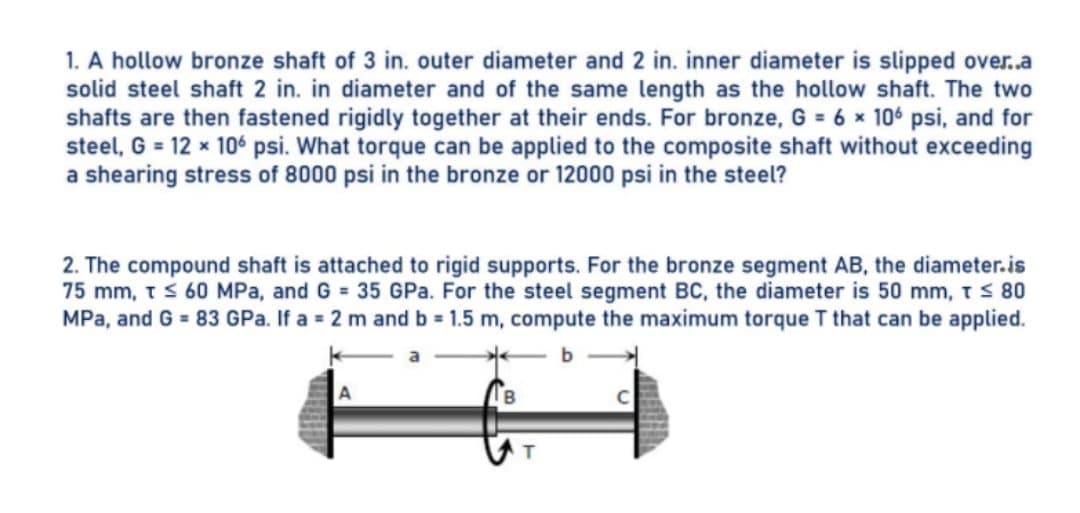1. A hollow bronze shaft of 3 in. outer diameter and 2 in. inner diameter is slipped over..a solid steel shaft 2 in. in diameter and of the same length as the hollow shaft. The two shafts are then fastened rigidly together at their ends. For bronze, G = 6 x 106 psi, and for steel, G = 12 x 10ʻ psi. What torque can be applied to the composite shaft without exceeding a shearing stress of 8000 psi in the bronze or 12000 psi in the steel?
1. A hollow bronze shaft of 3 in. outer diameter and 2 in. inner diameter is slipped over..a solid steel shaft 2 in. in diameter and of the same length as the hollow shaft. The two shafts are then fastened rigidly together at their ends. For bronze, G = 6 x 106 psi, and for steel, G = 12 x 10ʻ psi. What torque can be applied to the composite shaft without exceeding a shearing stress of 8000 psi in the bronze or 12000 psi in the steel?
Chapter2: Loads On Structures
Section: Chapter Questions
Problem 1P
Related questions
Question

Transcribed Image Text:1. A hollow bronze shaft of 3 in. outer diameter and 2 in. inner diameter is slipped over..a
solid steel shaft 2 in. in diameter and of the same length as the hollow shaft. The two
shafts are then fastened rigidly together at their ends. For bronze, G = 6 x 106 psi, and for
steel, G = 12 x 10 psi. What torque can be applied to the composite shaft without exceeding
a shearing stress of 8000 psi in the bronze or 12000 psi in the steel?
2. The compound shaft is attached to rigid supports. For the bronze segment AB, the diameter.is
75 mm, ts 60 MPa, and G 35 GPa. For the steel segment BC, the diameter is 50 mm, t S 80
MPa, and G = 83 GPa. If a = 2 m and b = 1.5 m, compute the maximum torque T that can be applied.
Expert Solution
This question has been solved!
Explore an expertly crafted, step-by-step solution for a thorough understanding of key concepts.
This is a popular solution!
Trending now
This is a popular solution!
Step by step
Solved in 2 steps

Knowledge Booster
Learn more about
Need a deep-dive on the concept behind this application? Look no further. Learn more about this topic, civil-engineering and related others by exploring similar questions and additional content below.Recommended textbooks for you


Structural Analysis (10th Edition)
Civil Engineering
ISBN:
9780134610672
Author:
Russell C. Hibbeler
Publisher:
PEARSON

Principles of Foundation Engineering (MindTap Cou…
Civil Engineering
ISBN:
9781337705028
Author:
Braja M. Das, Nagaratnam Sivakugan
Publisher:
Cengage Learning


Structural Analysis (10th Edition)
Civil Engineering
ISBN:
9780134610672
Author:
Russell C. Hibbeler
Publisher:
PEARSON

Principles of Foundation Engineering (MindTap Cou…
Civil Engineering
ISBN:
9781337705028
Author:
Braja M. Das, Nagaratnam Sivakugan
Publisher:
Cengage Learning

Fundamentals of Structural Analysis
Civil Engineering
ISBN:
9780073398006
Author:
Kenneth M. Leet Emeritus, Chia-Ming Uang, Joel Lanning
Publisher:
McGraw-Hill Education


Traffic and Highway Engineering
Civil Engineering
ISBN:
9781305156241
Author:
Garber, Nicholas J.
Publisher:
Cengage Learning